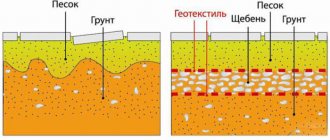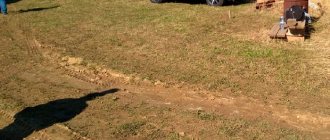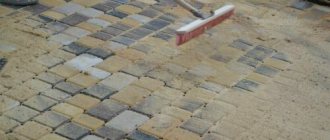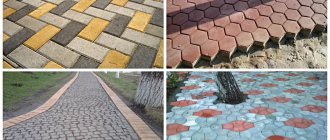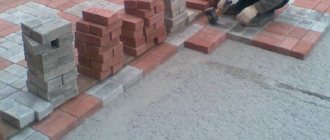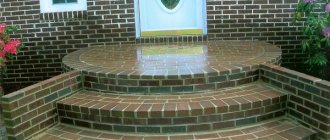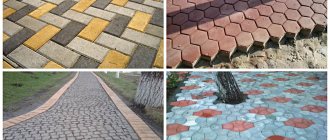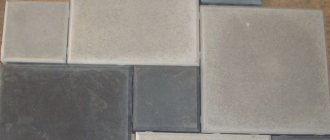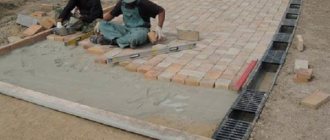Any paths or sidewalks paved with paving look elegant and aesthetically pleasing, which naturally pleases the eye. Especially if country paths are designed using this technique. Recently, paving slabs have gained immense popularity. First of all, because of their various shapes and colors, which allow you to decorate the landscape to suit every taste.
Paving slabs in the garden at the dacha
The quality of the paving surface depends on the constituent components. The composition of the solution for paving slabs, in addition to standard components, also includes special ones, which are called plasticizers. Their participation guarantees good quality of the solution, on which the final result depends. This article will tell you not only the properties and positive qualities of this element, but also tell you how to make it yourself.
Mortar for paving slabs
The composition of concrete for paving slabs contains several ingredients, including basic and additional ones.
Cement
Among the main components, cement plays a special role. There are several grades of cement, but cement grades ranging from 300 to 700 are considered suitable for the production of paving pavements. These indicators indicate the degree of compressive strength. The best option, and the most commonly used, is cement grade M500.
Mortar table with different grades of concrete
When purchasing cement, pay attention to several factors:
- Manufacturer.
- The consignment.
To avoid problems with the characteristics of this material, it is always necessary to buy the same batch of cement.
As for the manufacturer, there should be only one. Each manufacturer produces the material using its own technical process, so the material may vary slightly in color.
This can be avoided if you use cement from the same batch and from the same manufacturer.
Crushed stone and sand
In addition to cement, the solution contains crushed stone or sand. To improve the quality of the finished product, crushed stone is used, the fraction of which is 5–10 mm.
Price for crushed stone fractions 5-20 mm
When producing paving slabs in large quantities, in addition to the fraction, it is necessary to take into account frost resistance. The best option is to use crushed granite.
As for sand, it is no less important than other components. For the solution, you usually take clean sand that does not contain any impurities.
If the sand is slightly of poor quality, it can be sieved. The presence of clay should not exceed 5% of the total amount.
Plasticizers
Additional elements include a plasticizer and a dispersant.
At their core, both a dispersant and a plasticizer are mineral additives that work to improve the quality of the product, and in addition, it significantly simplifies the formation of paving material.
Table of plasticizer proportions
In addition, the finished product acquires waterproof qualities and, accordingly, durability. The use of mineral additives increases the strength of the finished material by 2 times. Frost resistance and elasticity indicators increase. A plasticizer and dispersant are used to achieve a glossy finish.
If you make paving slabs with your own hands, then in addition to these additives you need to add dyes.
On an industrial scale, iron oxide pigment dye is used. Only those dyes that meet certain criteria are selected:
- Do not fade when exposed to ultraviolet rays.
- Do not collapse under unfavorable climatic conditions.
The dispersant helps to grind any component until a homogeneous composition is obtained.
If the manufacturing process involves the use of Polish technology, then the dispersant must be dissolved in hot water, and only then added to the solution. The plasticizer is not so capricious; it is added in dry form.
A dispersant is always used for the first layer, and a plasticizer is reserved for the second layer. Regarding cement, additives should not exceed 0.15%.
How to choose a plasticizer when making paving slabs?
It must be remembered that the main purpose of the plasticizer in the manufacture of paving slabs is not to save cement, but to increase its durability, since strength can be ensured simply by using high-quality cement.
In addition, it is very desirable to make tiles from a highly plastic concrete mixture, since low-plasticity mixtures lead to a significant increase in labor costs (and, accordingly, prices) and do not guarantee its durability.
Therefore, the use of plasticizers in the manufacture of paving slabs is absolutely necessary. An important issue when choosing a plasticizer is also the combination of its effectiveness and price. Based on these considerations, a plasticizer should be selected.
So, in the manufacture of paving slabs, two main types of plasticizing additives can be used - superplasticizers and plasticizers, which for simplicity can be called strong, not very strong and weak. It should be noted that in specialized manuals for builders this classification has been expanded from 2 to 4 groups: super, strong, medium and weak plasticizing additives
and thus a choice must be made between these 4 categories. At the same time, it cannot be assumed that when making paving slabs always need to choose the strongest plasticizer. It must also be remembered that all plasticizers are also water-reducing additives (reducing additives) and that the less water in concrete, the stronger and more durable it is.
Reducing additives can be classified depending on the amount of water they can “remove” - super-reducing additives can reduce the amount of water by 20-40 percent. Conventional reducing additives reduce the amount of water from 5 to 20%. Moreover, water-reducing additives, which reduce water demand by a maximum of 5%, usually involve a large amount of air in concrete, which also negatively affects strength and durability.
Let's look at the strength of concrete in a little more detail. The carrier of strength in concrete is cement stone, which is formed in two stages - the setting stage and the hardening stage. Setting begins 2 - 4 hours after mixing with water. At the same time, some compounds in cement, mainly aluminates, when interacting with water, release heat, which increases the rate of hydration of cement stone. The less free water the concrete contains, the faster the setting (crystallization) process occurs.
The speed of concrete hardening is also affected by air humidity and temperature. Theoretically, for complete hydration of cement in concrete, only 18-20% of water by weight of cement is needed, but with such a small amount of water, concrete will be impossible to place in the mold, so in concrete, water usually makes up 50-60%, which has a bad effect on its strength.
Under normal conditions, demoulding of concrete products is possible on the 7th day, which is very inconvenient, both in the mass production of paving slabs at a factory and in their production at home. To speed up hardening (reduce the time required for stripping), it is necessary to reduce the water-cement ratio of the concrete mixture. But
as the amount of water in concrete decreases, it becomes too thick (hard). Such concrete is inconvenient to place in molds; defects are possible due to defects in the geometry of the tiles and the formation of internal cavities. The mobility of concrete can be increased by additionally introducing some more water into it. But, with every extra percentage of water, the strength decreases, and the durability of the tiles decreases even faster.
Paving slabs will have to be re-laid every two to three years due to their premature destruction. This is why water is replaced with plasticizers. In addition to the fact that the plasticizer allows you to reduce the amount of water in concrete, increasing its grade without reducing mobility, plus you can reduce the amount of cement in concrete without reducing strength.
Classification of plasticizers
Low plasticizing
ShchSPK, LHD, PFLK, VLHK, PMShch, PASch, SPD, SPD-m, SPDF, M1 (Mylonaft), ChSShch, GKZh-10, KChNR, NCChK
Medium plasticizing
Addiment BV-8, Sementol Delta, Peramin V, ACF-3M, PFS, UPB, B-1 (Lignopan), VRP-1, VRP-E50, S-1, PDK, LST
Highly plasticizing
Ddiment BV-3, VN Liquiaat WS, Plastiment BV40, WRDA, Betokem LP, KOD-S, KBM, OKZIL, MLS, NIL-21, NIL-20, MTS-1, KhDSK-3, KhDSK-1, LSTM-2 , B-3 (Lignopan), nuclear submarine (Aplassan)
Superplasticizers
S-3, 10-03, Dophen, Sika ViskoCrete-5-600, Sikament-FF, Melflux PP 100F, Melflux 1641F, Melment L10, Melment F, Lomar D, Chriso Fluid, Cormix, Coplast M1, Izola FM-86, Agiplast, MF-AR, NKNS 40-03.
The industry produces plasticizers for paving slabs of several types. It can be dry powder in bags or liquid in canisters. They increase the settlement of the concrete cone from 2 to 25 cm. The most popular superplasticizer in Russia is S-3. In stores it is presented as a dry dark brown powder or a liquid of the same color.
The dry product is stored for a year, and in the form of a solution - about 6 months, does not lose its properties even after freezing to minus 40 ° C or heating to +85 ° C. This superplasticizer can reduce water demand by up to 25% or increase the cone draft to 23 centimeters, frost resistance up to F500, and strength by 30%. The average (recommended) dosage of this plasticizer is from 0.4 to 0.6% by weight of cement.
As a result, paving slabs can have a 3-fold increase in frost resistance, a smooth front surface and removal of formwork in 8 hours instead of three days.
Rules for preparing concrete mixtures
All chemical additives for concrete are sold in original packaging with a mandatory indication of the proportions in which they should be diluted and detailed instructions for introducing them into the mixture. The main disadvantage of plasticizers of the first efficiency group (superplasticizers) is the unequal effectiveness for cements of different compositions. Some plasticizers have additional air-entraining properties.
When using such plasticizers, it is necessary to ensure that air entrainment is less than 5%, and the structure of the concrete product is microporous. When producing paving slabs, it is recommended to add a liquid plasticizer at the last stage of mixing the components. In the workshops of large enterprises, paving slabs are produced by automated equipment with minimal human intervention. In this case, separate containers are used for plasticizers and precise dispensers are used.
In conclusion, we can say that choosing a plasticizer in the manufacture of paving slabs is a very difficult matter and it is best to contact a professional concrete technologist , since this will save your money, ensure the presentation of the tiles (smooth front surface) and its durability.
Why are plasticizers needed?
Basic components for paving slabs
When making a mortar from a cement-sand mixture with your own hands, many people get a result in which the product crumbles.
The reason lies in the composition of the solution; it contains no adhesives. And, consequently, the strength of the product is unsatisfactory.
To eliminate this problem, you can add water. In this case, it will play the role of a plasticizer. After this, the mixture will be able to evenly fill the molds, forming an even and smooth surface.
If crushed stone is included in the solution, but without a plasticizer, the mixture will turn out to be insufficiently plastic and inactive, which will affect its distribution in shape. As a result of this distribution, the tile will consist of pits, voids or holes.
Cutting tiles without plasticizer - voids formed
But after the tiles dry, you can notice that the lower part of the tiles is thin and fragile. This occurs from the separation of components, the light ones rise and the heavy ones fall down. The result will be poor quality tiles, that is, defective tiles that will burst very quickly.
But even if the result is good, the tiles do not have cracks, the service life of such a material will still not be long. This is explained by the porosity of the product, and, consequently, water permeability. When exposed to frost, such tiles simply crumble.
Mixing the solution for the base layer
Let us give a specific example of maintaining proportions when making concrete for the main layer. 10-12 liters of water, 0.75 liters of plasticizer solution, 5 buckets of screenings, 3 buckets (36 kg) of cement and another 4 buckets of screenings are poured into the concrete mixer. No dye is added when making the solution of the main volume of the product. The mixture is also kneaded for 10-15 minutes until it reaches the consistency of sour cream and placed in a tub.
For reference: to prepare concrete at home for 1 m2 of paving slabs with a thickness of 4.5 cm, you will need:
- cement – 20 kg;
- ShchPS (screenings) – 70 kg;
- dispersant (first layer) – 0.09 kg;
- plasticizer (second layer) – 0.075 kg;
- pigment – 0.6-0.8 kg.
—>
Useful properties of plasticizers
In the production of paving slabs, manufacturers use a plasticizer for paving slabs. It acts as a complex additive that improves the quality of the finished material.
Table of properties of plasticizers
As a result, the following properties are acquired:
- Mobility and elasticity of the solution. By reducing the amount of water, the product gains greater density, strength, and frost resistance.
- Concrete solution absorbs liquid better.
- Increased strength characteristics for the mortar.
- The surface of the material is obtained without dimples. And holes.
- Eliminates cracks on the tiles, as well as prevents the mortar from sticking to the mold.
- The plasticizer prevents the occurrence of cracks on the surface, the solution does not stick to the mold;
- Pigment dyes are not washed out.
- Reduced creep and increased shrinkage properties.
- High frost resistance.
- Environmental friendliness of the material.
- The plasticizer can be presented in two forms:
- Powder.
- Solution.
It contains the following elements:
- Sodium sulfate - 7–10%;
- Polymethylene naphthalene sulfonate - 80%
- Moisture - 10%.
What is it made of?
Any paving stone consists of several components:
- cement;
- crushed stone;
- sand;
- plasticizers and other additives.
What kind of cement is needed?
The brand for the tiles should be selected in the range from 300 to 700. Strength indicators are needed because the paths will have to deal with loads, constant friction, temperature changes and adverse atmospheric conditions.
If we are talking about producing tiles at home, then use 400 grade. In any case, a private individual does not have industrial equipment that would allow the production of high-quality and luxury paving stones, so it is better to reinforce the tiles with a good brand of cement.
It is better to purchase cement from one batch and one manufacturer. The characteristics of cement may vary depending on the manufacturer, so this will affect the uneven quality of the finished tile.
Crushed stone and sand
The important components are crushed stone and sand. Crushed stone of a fraction of 5-10 mm is used, it is suitable for creating a homogeneous mixture for pouring tiles with the correct geometry.
Secrets of preparing paving slabs, what we lay and how we prepare them
Crushed granite is more frost-resistant, so it is better to use it in large-scale production. But this is not always easy, because the material is expensive.
The sand must be clean and free of impurities, such as various debris, soil, grass or clay. Such sand should be sifted so that the clay content is reduced to 5%. Another option is to purchase clean sand, which has already been sifted and cleaned by the seller.
Modifying additives
Plasticizers are added to the composition to increase the frost resistance and plasticity of the solution. This simplifies the manufacturing process and also ensures the strength characteristics of the finished product.
About the Betoplast plasticizer when preparing the solution
Many builders are faced with a problem: the solution does not have fluidity and plasticity, and the finished product crumbles over time. Plasticizers help with this.
But this is not the only purpose of modifying additives:
- Increasing the plasticity of the solution makes it easier to install
- The finished product does not chip or crack over time.
- Cement consumption is reduced by 10%, the solution requires less water.
- The homogeneity becomes higher, the density of the solution increases by 25%. Porosity, which negatively affects the durability of the cladding, is eliminated.
- The solution does not stick to the mold, but spreads well in it.
- No efflorescence appears on the finished product.
- The drying time of the mixture increases, which is useful in the hot season.
Dispersants play another role in the preparation of paving products. They are used for highly efficient grinding of pigments and prevent particle sticking. This is how dispersants are used when dyes are added to a solution.
You can find out what plasticizers are from this video
Dyes are added at the dry mixing stage because they do not dissolve in water. Therefore, dyes are added to cement, with which they are thoroughly mixed. To achieve a uniform color for all products, you need to approach this process responsibly.
Dyes must be added according to the instructions; insufficient quantities will lead to inconsistent color of paving stones and to the fact that they will fade in the sun.
Production technology
equipment for the production of paving slabs
The production process is not very complicated, it consists of several mandatory points:
- It begins with treating the molds with hydrochloric acid. You can also use lubricant, it’s even better than hydrochloric acid. You can make the lubricating composition yourself; for this you take used machine oil and water in a ratio of 1:3.
- After this, they take a plasticizer for paving slabs and a dye. A solution is prepared from these two components by adding a little warm water.
- Next we begin to make the solution. For it, cement and filler are taken in a ratio of 2:2. Before loading the components into the concrete mixer, it is necessary to moisten its walls with water.
- Cement and filler are poured into a concrete mixer.
- Dye, plasticizer and 4 liters of water are also added there.
- If soft fiber reinforcement is added to the solution, the properties of the product will noticeably improve.
- The process of mixing the solution begins. Please note that if the solution is prepared correctly, it should be heavy and dry. Therefore, the mixture is thoroughly mixed, preventing the formation of clots and lumps.
Video about plasticizer
Independent production
It’s easy to prepare a plasticizer for paving slabs with your own hands, saving money. You just need to follow the step-by-step steps and correctly prepare the plasticizer composition for paving slabs. Be sure to wear gloves when working with solutions.
You can prepare the supplement based on powder, soap or other product:
| The basis | Preparation |
| Lime (protection from mold, temperatures, plasticity, smooth surface) | Suppress the lime, prepare a mixture of sand and cement; add lime; ratio (external work 1:6) |
| Powder | Dilute the powder with water; one bag of cement - a glass of the product |
| Liquid soap | Bucket of dry cement - 2 tbsp. l. soap |
The table shows common options for preparing the additive, as well as how much plasticizer to add to paving slabs. As a plasticizer, try adding washing powder and even chicken protein to the solution. Glass and polyamide fibers are suitable for this purpose. The proportions of plasticizer for paving slabs are different in each case. Any additive should not exceed the norm - 1 kg per cubic meter of concrete.
What can replace plasticizer?
When making a material with your own hands, it is not always possible to purchase a production plasticizer. If you find yourself in such a situation, then the way out of it is quite simple; there are means that are not inferior in their characteristics to production materials:
- foam concentrate located in the fire department;
- dishwashing detergent;
- laundry soap, it must first be crushed and diluted with water;
- tile glue (you can use regular PVA glue);
- diluted washing powder.
Preparatory work
Before you start, before you start making the solution, do the following:
- Forms for filling are treated with hydrochloric acid. Another option is machine oil and water, which are diluted in a ratio of 1 to 3.
- A specialized plasticizer and dyes are mixed before preparing the solution. Dilute the solution according to the instructions and let it sit. You can prepare the plasticizer in the evening and just mix it in the morning. Or do it at the beginning of the work.
- Make sure the concrete mixer is clean before you begin. Various impurities are undesirable; they will affect the quality of the finished product. Wet the stirrer with water to prevent the solution from sticking to it.
Stages of self-receipt
When making plasticizer with your own hands, the savings in money are quite noticeable. But the process itself must be approached with all responsibility and care.
To get started you will need:
Using bar soap as a plasticizer, it is first ground on a grater.
- liquid soap;
- shampoo;
- washing powder (diluted with water).
Previously, chicken protein was used as a plasticizer. Builders always kept their secrets secret, passing them on from generation to generation. Many buildings still delight the eye with their beauty.
Sometimes slaked lime or fluff is used instead of soap. When using the second option, you can achieve stickiness and elasticity of the solution. This mixture is suitable for designing complex areas. The surface of tiles made from such a solution has a smooth and even surface.
The volume of plasticizer for the solution is calculated individually. It is customary to add soap at the very beginning, otherwise it will be absorbed by expanded clay or stone. Accordingly, the solution will not be of the required quality.
Despite all their positive properties, plasticizers also have negative ones. The main disadvantage is a lot of foaming. To avoid this, you can use substances with less foam formation. If this option is not possible, then you can pause work and wait until the foam settles.
Plasticizer for paving slabs: make it yourself
Making paving slabs with your own hands is not difficult. But to give it durability and improve its appearance, you need to add plasticizers to the concrete mixture. Special compositions are sold in hardware stores, although they can be successfully replaced with improvised means that everyone can find in their own kitchen or bathroom.
Why are plasticizers needed?
Sometimes home craftsmen, trying to make paving slabs with their own hands, encounter a problem: the concrete mixture refuses to “stick together,” and after drying, the finished blocks crumble and crumble under load. To avoid such problems, plasticizers are used. These are alkaline, chemically inert compounds that make working with concrete mortar easier and improve the quality of finished products.
Water plays the role of the main plasticizer in the concrete mixture.
Ready-made paving slabs consist of three components: cement, crushed stone and sand. When dry, this mixture is inelastic and full of voids. When water is added, the solution becomes fluid and easily fills the mold.
But water alone is not enough. Even if the tile turns out to be durable and without cracks, its service life is short due to the fact that the finished product is highly porous. The pores weaken the material and allow water to penetrate inside. In severe frosts, water freezes and destroys concrete from the inside. As a result, you have to replace the failed tiles with new ones every spring.
Due to temperature changes, the tiles quickly collapse
To avoid this problem, special additives are used. In addition to increasing frost resistance, plasticizers have a positive effect on other properties of both concrete mortar and finished products. In particular:
- the mobility and plasticity of concrete increases, the appearance of chips and other defects is prevented, the surface of the tile is not deformed;
- the solution absorbs water 10% less;
- cement consumption is reduced by 10–15%;
- the density of the solution increases by almost a quarter;
- the mixture becomes more homogeneous;
- sinks and voids are better filled, holes are leveled, the surface becomes smooth and even;
- the fluidity of the mixture increases, which facilitates the filling process;
- the solution does not stick to the mold;
- the strength of the dried mixture increases;
- during operation, paving slabs retain their original color;
- no efflorescence is formed;
- The water-repellent properties of the tiles increase.
In addition, in very hot weather, the plasticizer increases the drying time of the concrete mixture, which prevents it from cracking. And in the cold season, the solution does not freeze for a long time.
And finally, the use of plasticizers makes it possible to do without a vibrating table, that is, such concrete mixtures are self-compacting.
Plasticizers make it possible to avoid vibrocompression of workpieces
How to improve the quality of a concrete mixture with your own hands
Industrially produced additives are, of course, good, but they cannot always be found in the store. In addition, professional plasticizers are sold in ten-liter cans, and very little is added to the concrete mixture. Where to put the leftovers?
To make the perfect paving slabs with your own hands, you can use available materials as a plasticizer for the concrete mixture.
Detergents as additives
The soap solution is very fluid and penetrates even the smallest pores, enveloping every single particle. At the same time, the solution becomes more elastic and easier to work with.
Any alkaline-based detergents and cleaning products have plasticizer properties.
Every home will have:
- dishwashing liquid;
- washing powder;
- shampoo;
- liquid soap.
From an economical point of view, it is best to use soap. Household chemicals stores sell cheap liquid soap in five-liter containers. Sellers claim that it is builders who most often buy it. Ordinary bar soap is also used: it is ground on a grater and dissolved in hot water.
Using bar soap as a plasticizer, it is first ground on a grater.
Lime is a broad-spectrum plasticizer
Another material used as a plasticizer is lime.
Lime is used to increase the plasticity of the solution and prevent the appearance of cracks. Paving slabs made from such concrete are durable, even, smooth, and resistant to sudden temperature changes. If lime is used as a plasticizer, other types of additives cannot be added to the concrete mixture.
Ancient builders used egg white, which gave the finished structures special strength and durability.
Material consumption. Volumes and proportions
Liquid soap is added at the rate of 2 tablespoons per bucket of dry cement. Many experienced craftsmen, instead of soap, recommend adding 1 teaspoon of dishwashing detergent to this amount of cement .
If lime is used instead of a detergent, the desired level of stickiness and plasticity of the mixture is achieved experimentally. As a rule, when mixing mortar for casting paving slabs, a ratio of 6:1 is used (one part lime to six parts cement).
| Additive | Consumption |
| Liquid soap | 2 tbsp. l. per bucket of cement (12 kg) |
| Dishwashing liquid | 1 tsp. on a bucket of cement |
| Washing powder | 2 tbsp. l. with a slide on a bucket of cement |
| Slaked lime | no more than 20% by weight of cement |
Concrete mixer or shovel. What's better?
To prepare the concrete mixture, an electric concrete mixer is most often used. If you don’t have a concrete mixer, you can use a regular shovel and a container in the form of a large basin or trough.
It is more convenient to mix the solution by hand if liquid soap or dishwashing detergent is used as a plasticizer. In a concrete mixer, such additives can produce too much foam. Sometimes because of this you have to stop the unit and wait for the foam to subside.
How to properly add plasticizer to a solution
To prepare a concrete mixture for paving slabs, cement, water, sand, crushed stone, plasticizer and coloring pigment are gradually mixed. Soap is added at the first stage.
The soap solution is added at the very beginning of mixing.
If detergent is added later, it will be absorbed by the rubble. As a result, the solution will not achieve the required homogeneity and will have the same properties as if the plasticizer had not been added at all. To obtain a high-quality concrete mixture, all components are added in strict sequence:
- 20 liters of fresh clean water are poured into a concrete mixer and 4 tablespoons of liquid soap or 2 teaspoons of dishwashing liquid are added. Mix well. If washing powder is used, it must first be dissolved in a small amount of hot water.
- Iron oxide pigment is added to the liquid.
- Fill 2 buckets of crushed stone. After adding each subsequent component, the mixture is mixed well.
- Fill two buckets of dry Portland cement.
- Add another bucket of crushed stone.
- Fill in 4 buckets of coarse sand.
- Add the last bucket of crushed stone. Mix everything well.
Lime, like soap, is added at the first stage of mixing concrete.
If an industrial powdered plasticizer is used, it is pre-dissolved in a small amount of heated water. In cold water it can turn into sticky clumps.

